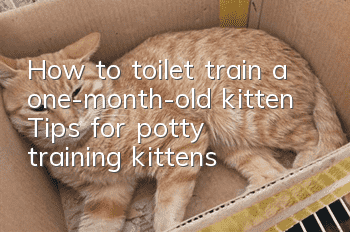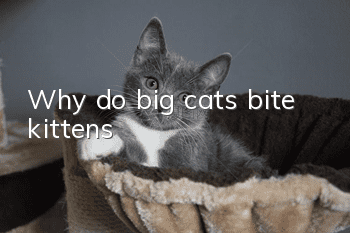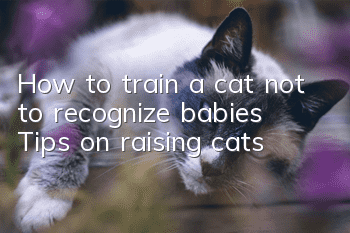How to toilet train a one-month-old kitten? Tips for potty training kittens

If you want to train a one-month-old kitten to use the toilet, you should train it through five methods: preparing the litter box, choosing cat litter, eliminating the smell of feces, correcting mistakes, and rewarding the right ones.
In nature, one-month-old kittens rarely urinate or defecate in the same place, or go to the toilet where other kittens have urinated and defecated. However, as a home-raised kitten, no matter how cute it is, if it urinates and urinates on the clothes or sofa at home, its cuteness will be greatly reduced, and the kitten's urine and feces can also spread bacteria and viruses.
We must train kittens to go to the toilet in the same place, even sharing a litter box with other cats. Let’s introduce the methods and precautions on how to toilet train a one-month-old kitten.
The first step in training a kitten to use the toilet: Prepare the potty
To train a kitten to urinate and defecate, you need to prepare a litter box in a quiet place with few people walking around. The area around the litter box should be relatively open and the kitten can enter and exit freely.
If the home is relatively large and the conditions are good, you can prepare two litter boxes, because kittens prefer one litter box to urinate and the other litter box to defecate. This is a cat's habit.
Finally, try not to choose a bedpan with a lid, because the lid of the bedpan can easily accumulate odors, and the unpleasant smell cannot easily dissipate.
The second step in training a kitten to use toilet and toilet: choose cat litter
Put 3-5 cm of cat litter in the litter box, and then put the kitten’s own urine or feces in the litter. Only when the kitten smells its own scent in the litter box will it be willing to defecate in the litter box. .
Cat litter is also divided into clumping and non-caking cat litter. If it is clumping cat litter, it can be absorbed into the urine and feces to cover the smell. Throw away the clumping cat litter after each kitten urinates. It needs to be replaced after 2 weeks of use. If it is non-clumping cat litter, it needs to be changed every day, otherwise the smell will be unpleasant.
The third step of training a kitten to toilet: eliminate the smell of feces
After preparing the litter box and litter for the kitten, clean up any traces of the kitten's defecation and defecation in other places, and wipe it with deodorant or cleaning agent several times to eliminate the smell of feces, so as to prevent the kitten from returning to the toilet. Go to the original place to relieve yourself.
The fourth step of training a kitten to use toilet and toilet: correct errors
When training a kitten in the early stages of toilet training, the kitten is not used to peeing in the potty yet. If it urinates in a place other than the potty, it must be yelled loudly to stop the ongoing urinating and defecation behavior, and it must be stopped immediately. Because if the punishment is given later, the kitten will not understand what it means.
The fifth step of training a kitten to use toilet and toilet: reward correctly
When the kitten urinates and defecates in the potty correctly, it should be rewarded in time, with more praise or food rewards, so that the kitten can think that it is correct. After several repeated trainings, the kitten will be trained in a fixed place. The habit of urinating and defecating.
Precautions for toilet training kittens
Sometimes, kittens will deliberately urinate outside the litter box. There may be the following reasons. Pet owners should pay attention to correct them in time:
1. The kitten may be disgusted with the size and placement of the litter box or the texture of the cat litter, or may simply be unwilling to bury it. At this time, the pet owner should change the litter box or cat litter in time;
2. The kitten has stones or urinary tract infection and is unwilling to go to painful places to urinate and defecate. At this time, the pet owner should check the kitten’s physical condition in time;
3. Kittens themselves have "enuresis" behavior, which will appear during fear or estrus. At this time, they will urinate everywhere, which requires timely examination and appropriate treatment.
The above is the answer to how to toilet train a one-month-old kitten. A one-month-old kitten is still young and can easily develop correct toileting habits. As long as you follow the above 5 steps, you can quickly train the kitten to the correct size. Convenience.
- Why does the cat keep licking itself?
- Can cats be allergic? Let’s talk about cats’ insect allergies!
- What are the domestic cat breeds? Domestic cat breed selection!
- What should I do if my cat likes to sleep on the bed? How to make my cat develop good habits
- Can cats still be vaccinated when they are two years old?
- Can cat ringworm be transmitted to humans? Causes and prevention of cat ringworm!
- Why do cats like to sleep next to their owners’ pillows?
- How to raise a cat to maturity
- Can cats eat pumpkin, cooked?
- What to do if your cat doesn’t like to drink water? These 5 tips to make your cat drink more water will help you!



